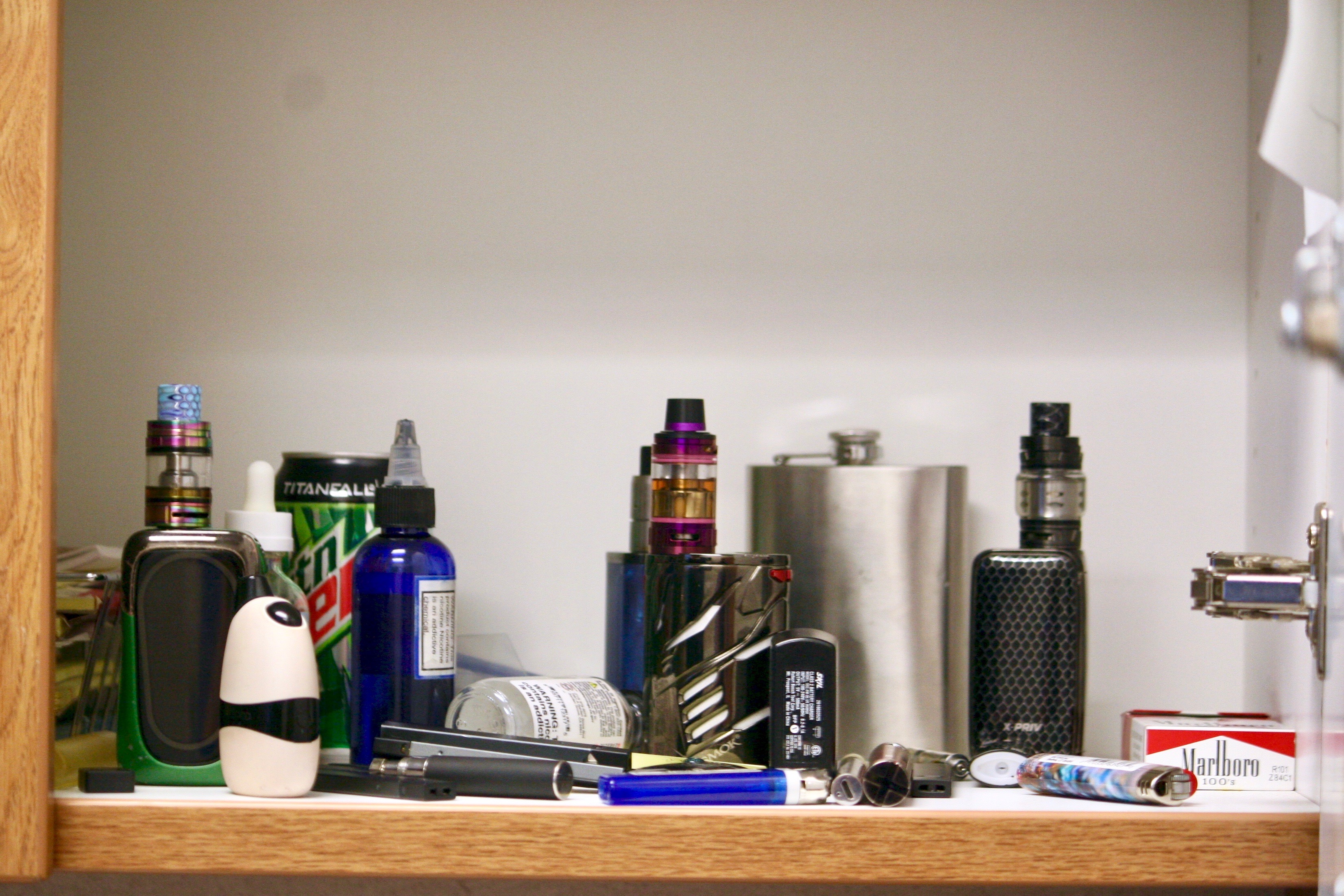
Read or listen to a Portuguese translation
Smoking isn’t what it used to be. Clouds of flavored vapor replaced tufts of smoke, and there is no ash. The classic paper tube gave way to a slim plastic rectangle with a grey matte finish and a USB plug.
But one thing hasn’t changed. Electronic cigarettes, commonly called “e-cigs” or “vapes,” often still pack a punch in terms of nicotine content. Vapes use heated coils to turn liquid or “e-juice” into clouds of flavored gas and nicotine for users to inhale.
One device, the Juul, uses flavor pods that each contain the same amount of nicotine as a pack of cigarettes, Valley High School Vice Principal Jacinto Peterson said. Peterson fears high school students are becoming hooked.
“I think cigarettes are not even close to this,” Peterson said. “My biggest concern is that it might be worse than tobacco.”
Peterson said Juuls pose a unique problem for multiple reasons. First, they are easier for students to conceal than tobacco. “It’s far more discrete,” he said. “It’s clandestine.”
According to Peterson, students typically use Juuls in bathroom stalls but sometimes even vape in the school’s hallways or in class. Since Juuls are so small, he said, they are easy to hide when a teacher or administrator is nearby.
“It looks like a USB stick,” Peterson said.
Second, Juuls and other electronic cigarettes open doors for students to become involved in other harmful behaviors. Peterson said he’s concerned students who vape will become addicted to nicotine.

“It’s going to be hard to put that genie back in the bottle,” he said.
Peterson said students may turn to tobacco to satisfy the demands of their addictions if vapes are unavailable, but tobacco might not be the only threat. Some devices use cannabis oil or other harmful ingredients, according to Peterson, and some students come to school high.
“You can make the mistake that they’re all tobacco-based,” Peterson said. “That’s not necessarily the case.”
Third, Peterson said, “it’s about respect.”
“I wouldn’t come into your house and vape,” he said. “Why would you come to a school, my house, your house — a shared space — and do that?”
Valley High School principal Sharon Jensen also expressed concerns about Juuls and other electronic cigarettes. She said they can be more appealing to kids than traditional tobacco.
“A lot of the students who use them are people who wouldn’t smoke a cigarette,” Jensen said. “It’s still dangerous, but it has less carcinogens, so students are more open to it.”
The National Youth Tobacco Survey, a yearly study by the Center for Disease Control, validates Jensen’s concerns. According to the 2017 Survey, 20.7 percent of sampled youth in the U.S. aged 9 and older have tried electronic cigarettes, compared with 17.4 percent of sampled youth who have tried traditional cigarettes.
Students often begin vaping because they see it as safer then regular tobacco or because they want to try different vape flavors, according to the survey. Juul flavors include mint, mango, cucumber, crème and fruit.
However, the survey also states young people most often begin to use e-cigarettes because they have friends and family members who vape. Valley High School health teacher C.J. Dzubak said she has seen this trend firsthand.
“You’re almost looked down upon if you don’t do it,” Dzubak said. “There’s a trend now. This is the cool thing to do.”

Dzubak said she is skeptical of claims that vaping is safer than smoking. Her students tell her they genuinely see it as safer than tobacco, but she thinks there’s not enough information about long-term effects to draw a conclusion.
“Doctors used to smoke. No one knew how bad it was,” Dzubak said. “Remember the Marlboro man? Every Marlboro man is dead.”
Juul Labs, which manufactures the Juul and its flavor pods, claims it doesn’t target its products to minors. In an online statement, CEO Kevin Burns called underage usage of the Juul a serious and unintended development.
“Our intent was never to have youth use JUUL products,” Burns said. “But intent is not enough, the numbers are what matter, and the numbers tell us underage use of e-cigarette products is a problem. We must solve it.”
Juul Labs announced it will terminate its social media presence and stop selling some flavors in retail stores, selling them only through its website using an age-verification system.
But, to Dzubak, these efforts are just vape and mirrors.
“These companies have targeted younger kids,” she said. “The flavors appeal to them. Sometimes our school smells like a fruit salad.”
Clint Ricord, who works at Smoke Spot, a South Jordan store which sells electronic cigarettes and other products, said his store cards people and tries to keep vapes out of the hands of high schoolers. However, he said students can get vapes the same way they used to get cigarettes.

“It’s a hard thing,” Ricord said. “Kids can get them from their friends or their older brothers who buy them.”
Smoke Spot owner Sunny Baig agreed.
“It’s mostly friends and family where kids get it from,” Baig said.
According to Baig, parents sometimes come in to buy vapes for their children, perhaps without understanding what they are or how they work.
“We know when they can’t pronounce the name of the product, or when the kid is waiting outside, that they’re buying it for their kid,” Baig said.
Ricord said Smoke Spot employees try to educate customers. But, Valley High School’s administration agreed, students should be educated without becoming customers in the first place.




